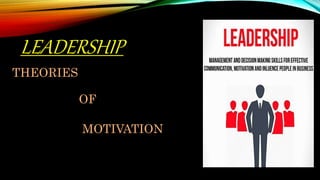
leadership theories of motivation pptx
- 2. SOMEIMPORTANTLEADERSHIPTHEORIESOFMOTIVATION MANAGERIAL GRID THEORY PATH GOAL THEORY LIKERT’S SCALE TRANSACTIONAL AND TRANSFORMATIONAL LEADERS
- 3. MANAGERIAL GRID THEORY This theory is proposed by Robert R. Blake and Jane Mouton. This model originally identified five different leadership styles base on the concern for people and the concern for production. Shown into 9*9 matrix =81 positions in which leadership style can be formed. Five important styles shown in figure are: (1,1) Impoverished leader (9,1) Task oriented (5,5) Middle of the road (1,9) Country club (9,9) Team management
- 4. PATH GOAL THEORY Developed by Robert House. This theory is based on specifying a leader’s style or behaviour that best fits the employee and work environment in order to achieve a goal. The goal is to increase your employees' motivation, empowerment, and satisfaction so they become productive members of the organization. The four path-goal types of leader behaviour are: - directive - supportive - participative - achievement
- 5. LIKERT’S SCALE Rensis Likert a social psychologist first described his famous management system in the 1960s ,based upon his observations of employee-manager relationship in organisation settings . The Likert management system is a theory about the various management styles a manager can adopt within in an organisation .In the ‘1960s, RENSIS LIKERT developed four management styles , intended to describe the relationship, roles and involvement of managers and subordinates in industrial environments. Likert’s four types of leadership style are: -Exploitative Authoritative -Benevolent Authoritative -Consultative -Participative leadership
- 6. Exploitative Authoritative: -System are highly hierarchical -Maximum power lies on the hand of top level management -Subordinates are not included in decision making -Top to bottom communication -Top level management takes all the credit but if there is any mistake the blame lower level management Benevolent Authoritative: -Responsibility and power is on the hand of top level management -Rather than pushing they reward for good performance. -Superior has more trust on employees ,they use participative decision making. -Two way communication is followed but upward communication is only positive(communicate what top level wants to hear )
- 7. Consultative: -Have greater trust on their subordinates -They value their subordinates -Team members are always consulted -Ultimate power lies with top level management -Employees motivation fueled with rewards and responsibility for certain task Participative leadership -most satisfying -They trust their subordinates -Lower management is valued -Free to discuss any issue -They can talk like lower to middle , middle to top or lower to top -No comparison
- 8. TRANSACTIONAL AND TRANSFORMATIONAL LEADERS • Transformational– leaders are charismatic leaders , they have a aura, personality. • They provide mission and vision to followers (why are we doing this, why it is important.) • Communicate high expectations – they communicate that every employee is valuable, focus on efforts. • He promotes intelligence (the people who thinks from brain not the buttering ones) • He coaches & advises. • They provides personal attention to the employees. • Transactional leaders • Give & take • Provides reward for good work • Intervene only when standards are not met. • Provide full freedom to employees(laissez faire style)